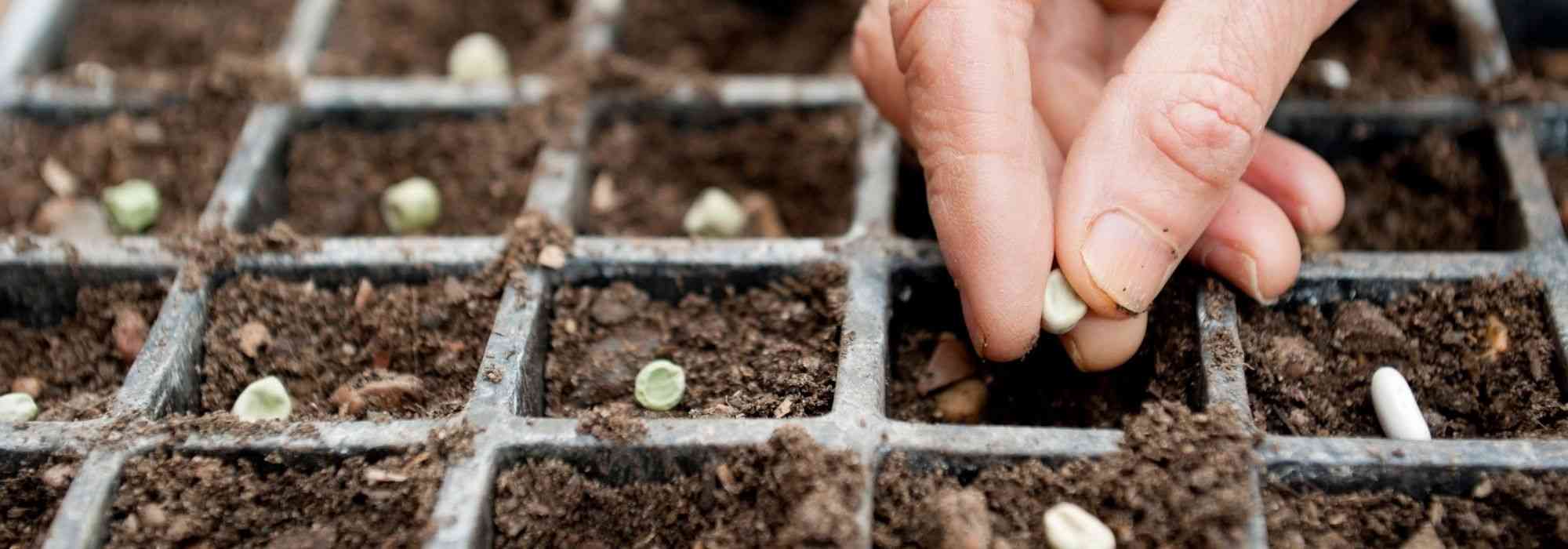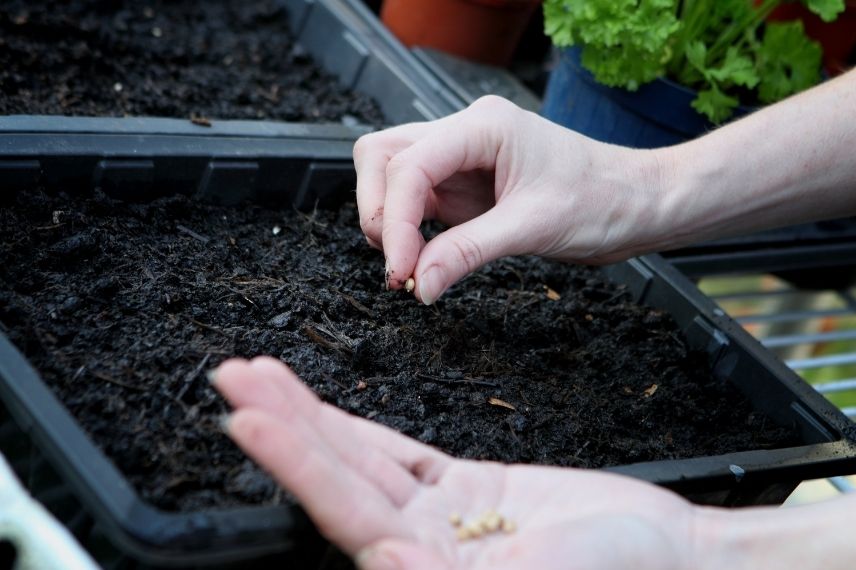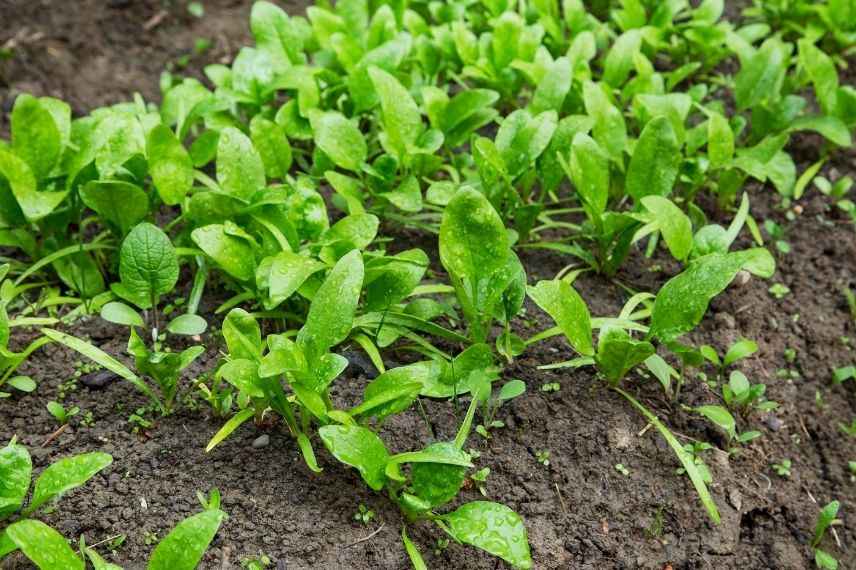
Vegetable garden calendar - March
Sowing and planting
Contents
March is just around the corner! And with it spring approaching (19th, 20th or 21st March depending on the year). Longer days inspire gardeners to get outdoors and enjoy their favourite pastime. But be cautious! March remains a month of unpredictability. Indeed, sudden showers combined with winds, sleet and late frosts must be taken into account, especially in cool climates for your sowing.
Nevertheless, March is still a busy month in the garden, and the list of tasks is fairly long — best not to fall behind!
Here is our list of vegetables to sow and plant in March.
Tender vegetables to sow indoors at home
In March, we are not yet safe from frosts and some vegetables require sowing under heated conditions.
-
Les tomatoes, peppers and chillies et aubergines
In March, there is still time to sow aubergine, pepper and chilli in mild climate such as on Mediterranean coast. However, in cooler climate, it is starting to be a little late. It is time to sow tomatoes. Sow in bucket or seed tray in heated space (15 to 20 degrees), with good light to ensure good growth. Space seeds well 1 to 2 cm apart then cover with a thin layer of potting compost. Spray to moisten.
⇒ Discover our advice to succeed in growing aubergines, peppers and chillies as well as tomatoes.
-
Le physalis
Likes warmth and has long growth (5 to 6 months before producing first fruits at end of summer). Needs about 20 degrees to germinate. Emergence can be a little slow, sometimes up to 3 weeks. Fill buckets with potting compost and place 3 seeds in each. Press them in lightly with finger and refill holes with compost. Water with a fine spray. Once Ice Saints have passed, you can transplant seedlings into garden.
⇒ For more information, see our advice sheet on growing physalis.
-
Le celeriac
Celeriac requires particular attention because of delicate germination; its growth starts very slowly. Sow seeds in seed tray indoors or under heated frame. Germination takes 12 to 15 days. Fill a seed tray with potting compost, firm down then thinly sow. Cover seeds very lightly with compost then firm slightly. Water by misting and keep moist without excess until emergence.
⇒ Discover our advice to succeed in growing celeriac.
Read also
Vegetable garden calendar - January
Vegetables to sow under unheated cover
Under unheated cover — cold greenhouse, polytunnel or cold frame — these vegetable varieties tolerate cool conditions but remain susceptible to frost. You can sow :
-
Most cabbages (cauliflower, broccoli, kohlrabi, Brussels sprouts or white cabbage)
In polytunnel, sow in rows. Dig furrows 1 to 2 cm deep then sow seeds. Cover with a thin layer of potting compost, firm lightly and mist. First seedlings will appear within 10 to 15 days. Prick out into bucket once at two-leaf stage. At 4–6 leaves, time to transplant to final position in garden, after Ice Saints. Don’t forget to water and watch for pests that love their tender foliage!
⇒ Check our dedicated page and you’ll know all about cabbage!
Sowing radishes is very simple. Sow forcing radishes now until the end of March. Then sow so-called every-month radishes from mid-March to mid-September. Sow in seed tray or bucket and harvest, depending on variety, 1 to 2 months later. We recommend sowing a little every 15 days to stagger harvests.
⇒ For everything about growing radishes, read our complete guide.
To germinate, seeds need a temperature of at least 10°C. Sowing in a seed tray under cover will be ample! They can take 2 to 3 weeks to appear. Once out, however, prick out mid-May (always after Ice Saints), when stems reach pencil thickness. For leek varieties, choose ‘Gros long d’été’, ‘Jaune gros du Poitou’ and ‘Géant précoce’.
⇒ Leeks: sow, plant, grow, harvest.
-
The lettuce
Lettuce can be sown from February in a seed tray under cover or from March outdoors under cold frame or tunnel. Seeds germinate at around 10–12°C. ‘Reine de mai’ lettuce is perfect to sow now. Sow a few seeds at intervals to spread harvests.
⇒ Discover how to succeed in sowing salads.
In a seed tray or in bucket, sow seeds and cover lightly with potting compost. Prick out seedlings into individual buckets when they have 3–4 leaves, then plant out in garden when risk of frost has passed. Direct sowing outdoors is possible but wait until after Ice Saints.
⇒ Our complete file: Sorrel: plant, grow, harvest
For early cropping, it is possible to sow beetroot seeds in March to prick out in April and expect a harvest from May to July.
⇒ For everything about its cultivation, see our complete page: Beetroot: sow, plant, grow.
Sow in bucket or seed tray to set out in garden when plants reach about 10 cm and after severe frosts. Parsley is fairly slow to germinate (around 20 days at 20°C on average, sometimes longer at lower temperature). To speed germination, soak seeds for 12 hours before sowing.
Sow 3 seeds in a bucket at 1 cm depth. Allow 3 months between sowing and planting outdoors; it is possible to sow from February in warmth indoors. When plants have 5 or 6 leaves, prick them out individually into larger buckets. Wait until plants are about 15 cm tall before planting out, when frosts are no longer a risk.
Read also
Vegetable garden calendar - February
Sowing in open ground, outdoors
March also heralds arrival of the first sowings in open ground! Keep a protective fleece to hand, just in case winter hasn’t yet had its last word.
Continue sowing carrots for an early harvest, around June/July. Sow into prepared soil, well weeded, deeply loosened and free of stones. Sow in rows and don’t sow too thickly. Germination takes 10 to 15 days.
⇒ Carrot sowing will hold no secrets for you thanks to our advice sheet.
Sow in rows, directly in place, on a part-shaded spot. Stagger sowings by sowing one or two short rows then repeating 15 days to 3 weeks later, and so on. Peas can be sown from late February in mild climates but wait until early March north of the Loire and protect with a fleece if severe frosts are forecast. It is also possible to sow seeds in buckets (5 seeds per bucket), to transplant into the garden later.
⇒ Our complete guide: Peas and garden peas: sow, to grow, harvest in the vegetable garden.
Sown in rows or broadcast, garden cress will perfectly flavour salads over a long period with its peppery taste. Germination is rapid, only 2 or 3 days after sowing (from a minimum of 18°C). After emergence, thin out and keep one seedling every 15 cm. Also leave 3 weeks between each sowing to stagger harvests.
Sow long-day varieties: ‘Matador’, ‘America’, ‘Junius’ in particular. Sowing is ideal in early spring so plants do not suffer from the unpleasant effects of summer heat. Sow in rows or broadcast, from early March to begin harvesting late April–early May. Then thin out to leave one plant every 10 cm. Do not hesitate to protect sowings with a tunnel if frosts are forecast. In cold climates, you can make first sowings under cold frame or polytunnel.
⇒ Our complete file: Spinach: sow, to grow and harvest in the vegetable garden
Sow in rows or 3 seeds per pocket every 40 cm then thin when plants have 3–4 leaves to leave one plant per pocket. Germination occurs in 6–10 days at 15–20°C. Do not hesitate to stagger sowings.
⇒ Orache: sowing, cultivation, harvest
Sow directly in rows for a harvest two months later.
Until the end of April, sow one seed every 5 cm, at 3–4 cm depth. Harvest will then begin at the start of summer. The colder it is, the longer germination will take. It takes 8 to 30 days depending on temperature.
⇒ Our family sheet: Broad bean: sow, to grow, harvest.
-
Salsify and scorzonera
From mid-March, sow in rows, directly in place. Take care to deeply loosen soil and remove stones. Thin to 10–15 cm when plants have 2–3 leaves.

Vegetables to plant in your vegetable garden
March is the ideal time to plant certain vegetables such as :
-
Potato
When soil is well warmed, plant the tubercles with the sprout facing upwards, in well-drained soil, 8–10 centimetres deep. Cover without firming. Choose varieties to suit culinary uses. ‘Charlotte’ is ideal for salads, steaming or pan-frying, whereas ‘Bintje’ is perfect for chips, mash or baking.
⇒ Our advice sheet : Planting potatoes.
Plant in very well-drained soil, spacing one bulbil or bulblet every 12 cm for pink garlic, 15 cm for onion and 20 cm for shallot.
⇒ All of Ingrid’s secrets on growing garlic, onions and shallots.
Plant asparagus crowns in the ground, taking care over the planting. It takes 3 years of cultivation before the first harvest can be expected.
⇒ For successful planting, read : Planting asparagus.
In March, in the vegetable garden, it’s also a good time to…
- Use a grelinette on your plots to loosen the surface and prepare it;
- Feed your soil in advance with a natural fertiliser rather than boosting your plant with conventional fertilisers;
- Begin carefully to remove winter covers such as mulch to allow soil to warm up gradually;
- Ventilate tunnels, greenhouses and cold frames when weather allows;
- Chop and incorporate green manures sown to return their benefits to the soil;
- Continue planting trees/bushes as bare roots outside frost periods.
Sowing, planting and harvest calendar
| Jan | Feb | Mar | Apr | May | Jun | Jul | Aug | Sep | Oct | Nov | Dec | |||||||||||||
| Pink garlic | ||||||||||||||||||||||||
| Orache | ||||||||||||||||||||||||
| Artichoke | ||||||||||||||||||||||||
| Asparagus | ||||||||||||||||||||||||
| Aubergine | ||||||||||||||||||||||||
| Carrot | ||||||||||||||||||||||||
| Celeriac | ||||||||||||||||||||||||
| Cauliflower | ||||||||||||||||||||||||
| Broccoli | ||||||||||||||||||||||||
| Brussels sprout | ||||||||||||||||||||||||
| Cabbage | ||||||||||||||||||||||||
| Kohlrabi | ||||||||||||||||||||||||
| Shallot | ||||||||||||||||||||||||
| Spinach | ||||||||||||||||||||||||
| Broad bean | ||||||||||||||||||||||||
| Cut-and-come-again lettuce | ||||||||||||||||||||||||
| Spring lettuce | ||||||||||||||||||||||||
| Turnip | ||||||||||||||||||||||||
| Onion | ||||||||||||||||||||||||
| Sorrel | ||||||||||||||||||||||||
| Parsley | ||||||||||||||||||||||||
| Physalis | ||||||||||||||||||||||||
| Chilli / pepper | ||||||||||||||||||||||||
| Summer leek | ||||||||||||||||||||||||
| Autumn leek | ||||||||||||||||||||||||
| Round pea | ||||||||||||||||||||||||
| Wrinkled pea | ||||||||||||||||||||||||
| Mangetout pea | ||||||||||||||||||||||||
| Potato | ||||||||||||||||||||||||
| Forcing radish | ||||||||||||||||||||||||
| All-month radish | ||||||||||||||||||||||||
| Rhubarb | ||||||||||||||||||||||||
| Rocket | ||||||||||||||||||||||||
| Salsify, scorzonera | ||||||||||||||||||||||||
| Tomato | ||||||||||||||||||||||||
| sowing | |
| Pricking out, planting | |
| harvest |
please note
This sowing calendar is provided for guidance. Bear in mind that sowing, pricking out, planting and harvests may be earlier or later depending on region and weather. Different varieties of the same vegetable may also yield earlier or later harvests.
You can refer to our map to find which climate zone corresponds to your geographical area.
Before sowing or planting your vegetables and herbs, take the weather into account and check the weather forecast for the coming days. Indeed, no garden is immune to a late frost that could jeopardise emergence or survival of young seedlings. Similarly, assess the condition of your soil… if it is waterlogged or particularly cold, wait a while!
- Subscribe!
- Contents
































Comments